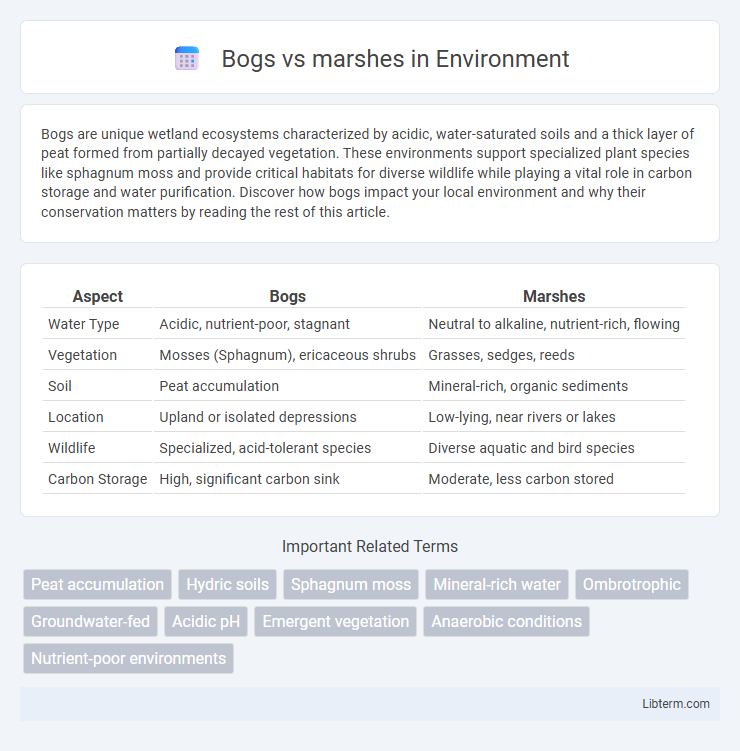Bogs are unique wetland ecosystems characterized by acidic, water-saturated soils and a thick layer of peat formed from partially decayed vegetation. These environments support specialized plant species like sphagnum moss and provide critical habitats for diverse wildlife while playing a vital role in carbon storage and water purification. Discover how bogs impact your local environment and why their conservation matters by reading the rest of this article.
Table of Comparison
| Aspect | Bogs | Marshes |
|---|---|---|
| Water Type | Acidic, nutrient-poor, stagnant | Neutral to alkaline, nutrient-rich, flowing |
| Vegetation | Mosses (Sphagnum), ericaceous shrubs | Grasses, sedges, reeds |
| Soil | Peat accumulation | Mineral-rich, organic sediments |
| Location | Upland or isolated depressions | Low-lying, near rivers or lakes |
| Wildlife | Specialized, acid-tolerant species | Diverse aquatic and bird species |
| Carbon Storage | High, significant carbon sink | Moderate, less carbon stored |
Introduction to Bogs and Marshes
Bogs and marshes are distinct types of wetlands characterized by unique water chemistry and vegetation. Bogs typically form in cold climates with acidic, nutrient-poor conditions and are dominated by sphagnum moss. Marshes, in contrast, are nutrient-rich wetlands found in more temperate areas, supporting a diverse array of grasses, reeds, and aquatic plants.
Defining Bogs: Key Features
Bogs are wetlands characterized by acidic, nutrient-poor conditions and a thick accumulation of sphagnum moss, which creates a unique environment for specialized plant species such as carnivorous plants and ericaceous shrubs. Unlike marshes, bogs receive water primarily from precipitation rather than groundwater or surface water, leading to low oxygen levels and slow decomposition rates that result in peat formation. These key features make bogs distinct ecological habitats crucial for carbon storage and biodiversity conservation.
Understanding Marshes: Essential Characteristics
Marshes are wetlands dominated by herbaceous plants such as cattails, reeds, and grasses, thriving in nutrient-rich, shallow waters with slow-moving or stagnant conditions. These ecosystems play a crucial role in water filtration, flood control, and providing habitat for diverse wildlife, including amphibians, birds, and fish. Unlike bogs, marshes have higher pH levels and nutrient availability, supporting more diverse and productive plant communities.
Differences in Water Sources
Bogs primarily receive water from precipitation, resulting in nutrient-poor, acidic conditions that support sphagnum moss and specialized plant species. Marshes are fed by surface or groundwater, creating nutrient-rich, alkaline environments that sustain diverse grasses, reeds, and aquatic plants. These contrasting water sources fundamentally shape the ecological characteristics and species composition of bogs and marshes.
Soil Composition and Nutrient Levels
Bogs have acidic, nutrient-poor soil primarily composed of peat, created from partially decomposed sphagnum moss that limits microbial activity. Marshes, in contrast, feature nutrient-rich, alkaline, or neutral soils with higher levels of organic matter and minerals due to the regular influx of water carrying sediments. This soil composition results in marshes supporting more diverse and abundant plant life compared to the specialized vegetation typical of bog environments.
Plant Life in Bogs vs Marshes
Bogs primarily support sphagnum mosses, ericaceous shrubs, and acidophilic plants adapted to nutrient-poor, acidic, and waterlogged conditions. Marshes feature a diverse range of hydrophytic plants such as cattails, sedges, and grasses thriving in nutrient-rich, alkaline or neutral waters. The distinct plant assemblages reflect the contrasting pH levels, water chemistry, and nutrient availability in bogs compared to marshes.
Animal Habitats and Biodiversity
Bogs support unique animal habitats with specialized species such as carnivorous insects, amphibians like frogs, and birds adapted to acidic, nutrient-poor conditions. Marshes provide rich biodiversity, hosting diverse amphibians, waterfowl, fish, and mammals due to their nutrient-rich, alkaline waters and abundant vegetation. Both ecosystems are crucial for maintaining regional wildlife populations but differ in species composition and habitat complexity.
Ecological Importance and Functions
Bogs are acidic wetlands with sphagnum moss that store large amounts of carbon, playing a critical role in climate regulation, while marshes are nutrient-rich wetlands dominated by grasses and reeds that support high biodiversity and improve water quality by filtering pollutants. Bogs act as natural water reservoirs boosting groundwater recharge and habitat for specialized species like carnivorous plants, whereas marshes provide essential breeding grounds for fish, amphibians, and migratory birds. Both ecosystems contribute significantly to flood control and nutrient cycling, sustaining regional ecological balance and biodiversity.
Human Impact and Conservation Efforts
Bogs and marshes face significant threats from human activities such as drainage for agriculture, urban development, and pollution, which disrupt their unique ecosystems and reduce biodiversity. Conservation efforts include wetland restoration projects, pollution control, and legal protections under frameworks like the Ramsar Convention to preserve these vital habitats. Protecting the hydrology and native vegetation of bogs and marshes is crucial to maintaining their carbon storage capabilities and supporting diverse wildlife populations.
Conclusion: Choosing Between Bogs and Marshes
Bogs provide acidic, nutrient-poor environments ideal for specialized plant species like sphagnum mosses and carnivorous plants, while marshes offer nutrient-rich, alkaline conditions that support diverse grasses, reeds, and aquatic fauna. Selecting between bogs and marshes depends on the desired ecological characteristics, such as water chemistry, plant communities, and wildlife habitat preferences. Effective wetland management requires understanding these distinct hydrological and biological features to promote conservation or restoration goals.
Bogs Infographic

 libterm.com
libterm.com